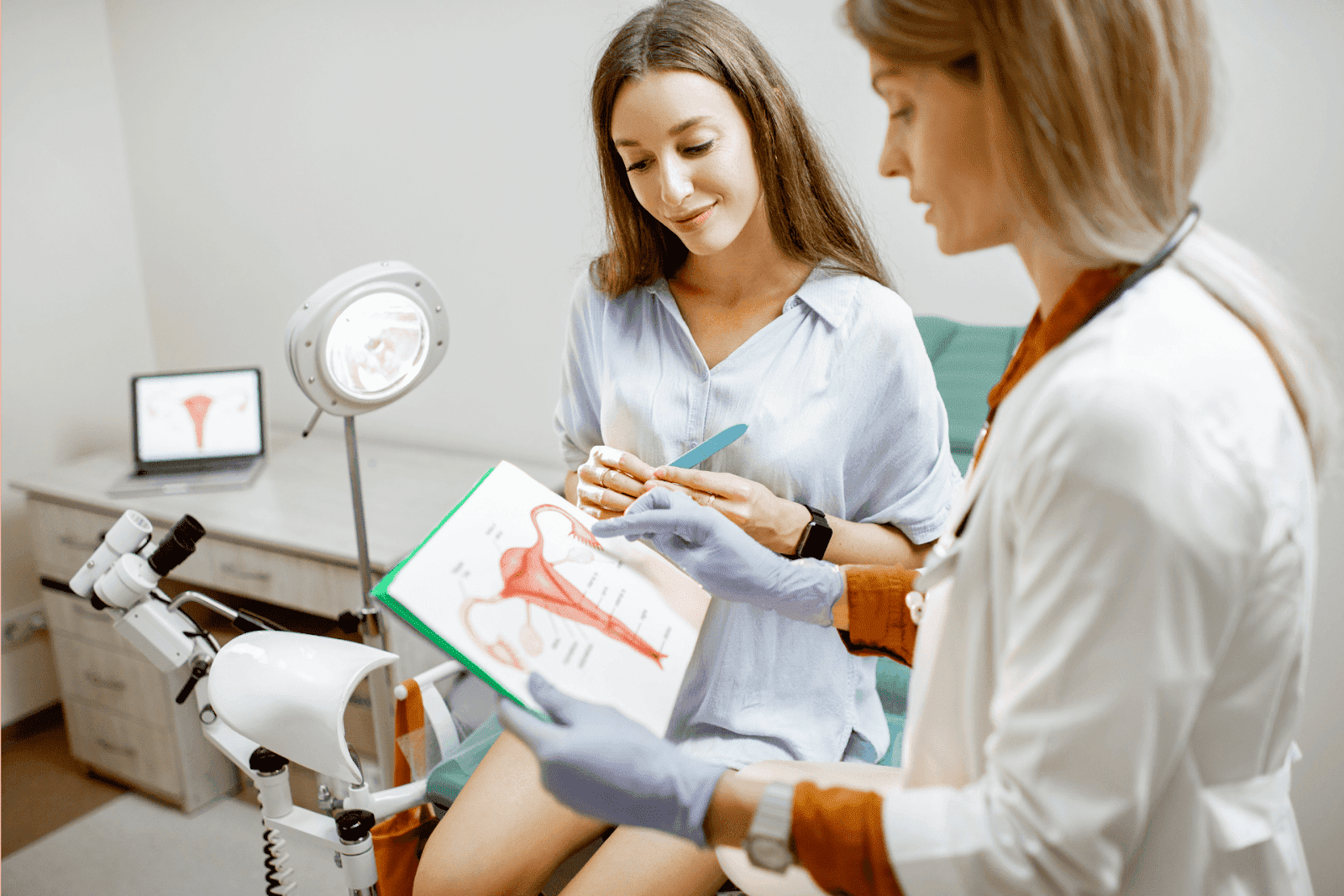Does Gabapentin Help with Sciatica?
Sciatica can cause sharp pain that shoots down your leg, making simple tasks hard. Many people wonder if gabapentin, a common medication, can ease this pain. This article [...]
Read More
Medically reviewed by Abhijit Bhattacharyya | MD, PhD, MBA, Tufts University School of Medicine - Miami, Florida on August 18th, 2025.
Itchy, burning, or an unusual discharge can be alarming. Vaginal symptoms are common and usually not dangerous, but they can be uncomfortable, and misinterpreting them can lead to delays in effective treatment. This article explains what a yeast infection (vulvovaginal candidiasis) typically looks and feels like, how it differs from other causes of vaginal discomfort, when to seek medical care, and how modern telehealth can make diagnosis and treatment easier and faster.
 What is a yeast infection?
What is a yeast infection?A yeast infection is an overgrowth of Candida, a type of fungus that normally lives in small amounts in the vagina, mouth, digestive tract, and on the skin. When the natural balance of microorganisms is disturbed, Candida can multiply and cause symptoms known as vulvovaginal candidiasis.
Most yeast infections are caused by Candida albicans, though other species can be responsible. These infections are not sexually transmitted in the traditional sense, but sexual activity can sometimes contribute to changes that trigger symptoms.
Vulvovaginal candidiasis is extremely common. Around 75% of people with vaginas will experience at least one episode in their lifetime, and up to 40% will have recurrent episodes. These infections are especially common during pregnancy, after antibiotic use, or when hormonal changes occur.
Classic symptoms of a yeast infection include intense itching, a burning sensation in the vulva, and a characteristic vaginal discharge. These features help distinguish yeast infections from other conditions, but an overlap exists with other infections and skin conditions.
Itch and irritation: Itching is the most common symptom. It can range from mild to severe and is usually centered on the vulva (the external genital area) rather than deep inside the vagina.
Discharge: The discharge associated with yeast infections is often described as thick, white, and cottage cheese-like. It usually has little or no odor. Amount and consistency can vary; some people have heavy discharge, while others notice only minimal changes.
Burning during urination or intercourse is common with active inflammation, as is redness and swelling of the vulvar tissue. Small cracks or fissures in the skin may develop, particularly after scratching or in severe cases.
Several conditions can cause vaginal itching, discharge, or burning. The most commonly confused problems are bacterial vaginosis (BV), sexually transmitted infections (STIs) like trichomoniasis or herpes, and dermatitis or allergic reactions. Each has distinguishing features.
BV tends to cause a thin, grayish discharge with a strong "fishy" odor, especially after sex. Itching may be present, but it is often less intense than with a yeast infection. BV reflects an imbalance of the vaginal bacteria rather than a fungal overgrowth.
Trichomoniasis can cause frothy, yellow-green discharge with a foul smell and notable irritation. Herpes often causes painful sores and blisters rather than just itching or discharge. If symptoms include ulcers, severe pain, or bleeding, STI testing is important.
Soaps, scented products, laundry detergents, and friction from clothing can cause contact dermatitis. Symptoms may mimic an infection, redness, itching, and scaling, but discharge is typically absent. A trial of avoiding irritants and using gentle skin care can help distinguish dermatitis from an infectious cause.
Consider a yeast infection when itching is severe, discharge is thick and white, and there is no strong foul odor. If symptoms follow antibiotic use, hormonal shifts, pregnancy, or diabetes, a yeast infection becomes more likely.
If symptoms are unusual, such as heavy bleeding, high fever, severe pain, ulcers, a very foul odor, or symptoms that don’t respond to over-the-counter treatment, seek prompt medical evaluation to rule out other conditions.
Self-assessment can be helpful but has limits. Over-the-counter antifungal creams and suppositories are effective for many straightforward yeast infections. However, self-treatment based solely on symptoms can be wrong up to 40% of the time because of overlapping features with other infections.
Professional diagnosis often includes a pelvic exam and testing of vaginal secretions. A provider may perform a microscopic exam of discharge, a pH test (yeast infections typically do not raise vaginal pH), or lab cultures to identify non-albicans species that may require different treatment.
There are rapid home tests that can detect changes in vaginal pH or identify Candida-specific components, and some over-the-counter kits allow for vaginal swabs to be mailed to a lab. These can help when symptoms are uncertain, but they’re not foolproof. A telehealth visit with a clinician can evaluate symptoms, review medical history, and guide testing decisions.
Most uncomplicated yeast infections respond well to antifungal medications. The main options include topical azole antifungals (creams, ointments, or vaginal suppositories) and oral fluconazole. Treatment choice depends on severity, frequency of recurrence, pregnancy status, and whether the infecting species is typical Candida albicans or a different strain.
Topical therapies are available over the counter and typically used for 1–7 days depending on the product strength. Single-dose oral fluconazole is effective for many cases but should not be used during pregnancy without medical advice.
Recurrent vulvovaginal candidiasis is defined as four or more episodes in one year. Recurrent or severe infections often require longer courses of antifungal therapy and sometimes maintenance dosing. Non-albicans Candida species can be less responsive to azoles and may need alternative medications or specialist consultation.
While not all cases are preventable, certain habits reduce risk. Avoid unnecessary antibiotic use, maintain good blood sugar control if diabetic, and choose breathable, cotton underwear. Avoid douching and heavily scented feminine hygiene products, which can disrupt the vaginal microbiome.
Simple lifestyle measures, such as wearing loose-fitting clothing, changing out of wet swimsuits promptly, and using gentle, fragrance-free soaps, can also help reduce irritation and recurrent episodes.
Most yeast infections can be managed without emergency care. However, urgent evaluation is warranted for severe pain, high fever, swelling that makes urination impossible, extensive sores or blisters, or if symptoms suggest a different diagnosis, such as an STI. Pregnancy also changes management: pregnant people with vaginal symptoms should consult a clinician before taking medications.
For non-urgent but prompt care, modern telehealth services provide quick access to clinicians who can evaluate symptoms, recommend testing or treatment, and prescribe medications when appropriate. For example, Doctronic.ai offers convenient telehealth video visits with licensed doctors 24/7 in all 50 states and free AI-powered visits that review symptoms and provide guidance. These options can save time and help determine whether in-person testing is needed.
 Using Telehealth Wisely for Vaginal Symptoms
Using Telehealth Wisely for Vaginal SymptomsTelehealth is a practical first step for many people. A virtual visit allows a clinician to take a detailed history, observe certain signs, and decide whether testing or an in-person exam is required. Electronic prescriptions can be sent directly to a pharmacy for common antifungals when appropriate.
Doctronic.ai combines an AI-driven diagnostic assistant with access to licensed clinicians for real-time video visits. The AI visit is free, offering rapid, evidence-based guidance powered by the latest peer-reviewed medical knowledge, and telehealth visits with doctors are inexpensive and available around the clock. This model provides both speed and continuity, which is especially helpful for people with recurrent problems who want a consistent care pathway.
Pregnant people commonly experience yeast infections due to hormonal changes. Some topical antifungal options are considered safe in pregnancy, but oral medications are typically avoided unless prescribed by a clinician. Always consult a provider before starting treatment during pregnancy.
People with diabetes, especially if poorly controlled, are more prone to yeast infections, and managing blood sugar is an important part of prevention and treatment. Those with compromised immune systems, due to medications, HIV, or other conditions, may experience more severe or persistent infections and should seek medical supervision early.
Over-the-counter antifungals work well for many uncomplicated cases. Follow package directions and complete the recommended course, even if symptoms improve quickly. Avoid home remedies that lack evidence, some natural treatments can further irritate delicate tissues or mask symptoms of another illness.
If symptoms recur shortly after treatment, worsen, or differ from previous episodes, a clinician should re-evaluate the diagnosis. Diagnostic tests can identify non-albicans species or other causes that need different therapies.
Avoid douching, scented wipes, or perfumed soaps. These products can alter the vaginal environment, making infections more likely and complicating diagnosis. Barrier protection like condoms can reduce exposure to potential irritants during sex, and lubricant choices should be water-based and fragrance-free.
During a visit, virtual or in-person, a clinician will ask about symptoms, recent antibiotics, sexual history, menstrual status, pregnancy status, and any prior episodes or treatments. A physical exam and lab tests may follow if the diagnosis is uncertain or symptoms are severe.
Results from lab tests usually arrive within a few days. In many straightforward cases, treatment may begin during the first visit based on clinical judgment, with follow-up recommended to confirm symptom resolution.
Recent antibiotic use is a common trigger for yeast infections because antibiotics can reduce levels of beneficial bacteria that normally keep Candida in check. If antibiotics are necessary, concurrent probiotic strategies or close monitoring may help, but evidence varies and individual guidance from a clinician is recommended.
Hormonal contraceptives and hormone replacement therapy can also influence risk, though the effect is variable and usually minor compared with other factors like antibiotics or diabetes.
Itch, burning, or abnormal discharge can be caused by a yeast infection, but other conditions overlap with these symptoms. Accurate diagnosis matters because treatment differs across conditions. For uncomplicated cases, over-the-counter antifungal treatments often work, but persistent, recurrent, or severe symptoms require clinician evaluation.
Telehealth offers fast, accessible care for most non-emergency situations. Services that combine AI-guided assessment with licensed clinician visits, such as Doctronic.ai, can provide rapid, evidence-based guidance and affordable video visits 24/7. Visit Doctronic.ai to start a free AI visit or book a telehealth appointment with a doctor for personalized care and prescription when needed.
When in doubt, seek professional evaluation rather than guessing. Prompt, appropriate care reduces discomfort and the chance of complications, and modern telehealth makes that care accessible on a schedule that fits daily life.
If you’re unsure whether your symptoms are a yeast infection or something else, Doctronic can help you decide the next steps in seconds. Our AI Doctor, trusted by over 10 million people and built on the latest peer‑reviewed medicine, offers free AI visits you can take to any clinician, plus convenient video visits with licensed doctors 24/7 in all 50 states for under $40. Skip the uncertainty and get a personalized, evidence‑based plan from Doctronic, the #1 AI Doctor headquartered in NYC. Skip the line. Talk to an AI Doctor Now, for free.
Sciatica can cause sharp pain that shoots down your leg, making simple tasks hard. Many people wonder if gabapentin, a common medication, can ease this pain. This article [...]
Read MoreBack pain is one of the most common health complaints, affecting millions of people worldwide. If you have back pain, you might have heard about gabapentin as a possible [...]
Read MoreIf you take gabapentin, you might wonder if it will show up on a drug test. This question matters for many people, whether it’s for work, sports, or legal reasons. Gabapentin [...]
Read More